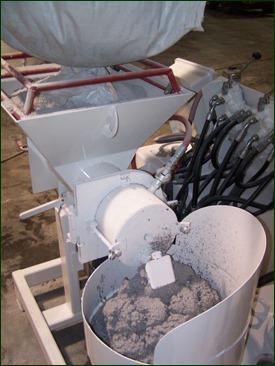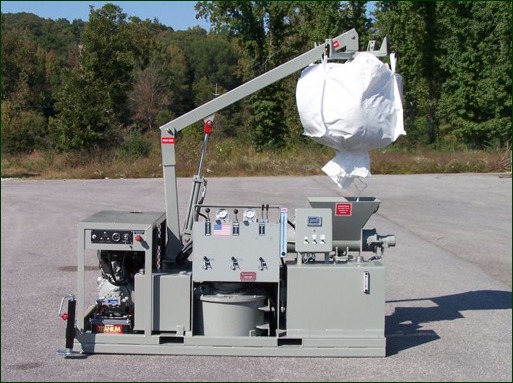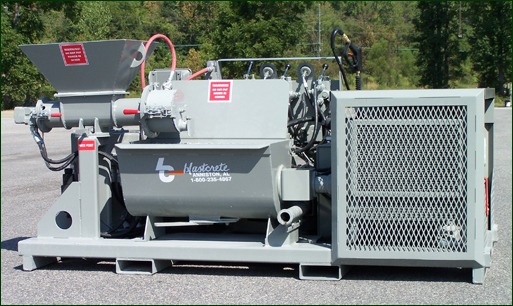Mixers, Pumps & Delivery Systems
Team Effort
??Companies team up to create a revolutionary new product for the masonry industry
Imagine a conversation about racecars between NASCAR’s Richard Petty and Henry Ford, airplanes between Orville Wright and Howard Hughes, or computers with Bill Gates and Steve Jobs. Two bright minds that eat, sleep and breathe their industries would, no doubt, share exciting ideas and possibly invent something new for the future.
In September 2006, a real conversation and exchange of ideas took place between two thought leaders in the concrete and masonry industries, Blastcrete Equipment Co.’s president, Jim Farrell, and Jollay Masonry owner, Dave Jollay.
While that conversation may not seemingly compare to those aforementioned, it did result in the design of a machine that could help revolutionize the masonry industry: Blastcrete’s Mason Mate.
 |
|
| Mortar Mate at work. |
Initial discussions
Farrell and Jollay, along with Blastcrete’s Craig Maddox, originally sat down to help resolve material handling issues for masonry grout in specific job applications. It was then that Jollay, whose company resume as mason contactor includes such projects as Turner Field, Phillips Arena, and the Georgia World Congress Center (all in Atlanta), really got Farrell’s attention with one powerful comment: “Even with all the equipment and material improvements over the last 50 years, many of the basic installation and logistic challenges have remained the same,” Jollay said.
Jollay continued on to explain that the current design emphasis by structural engineers is to increase amounts of grout fill for concrete masonry unit (CMU) walls, even when non-loadbearing. This, combined with the challenge of alternate wall systems, cost inefficiencies, lack of jobsite storage, and safety concerns with dust exposure, proves that a need for an engineered solution for grouted CMU walls truly exists, particularly for interior scope and high-rise structures.
Farrell, who purchased 60-year-old Blastcrete Equipment Co. in 1983, had a history of thinking outside the box and really listening to his customers. While Blastcrete did not have a long history in the masonry business, Farrell recognized that a willing resource with as much experience as Jollay could be the architect to help the company develop an innovative machine for the mason. It was then the idea for the Mason Mate was born.
“When Dave (Jollay) and I sat down, the first basic idea we agreed on was that the machine should be placed as close to the masons as possible,” Farrell says. “Sounds simple, but it was a revolutionary idea.”
Indeed it was. That’s because, historically, grout and mortar have been mixed and transported, either pumped or hauled long distances, in a mortar box with an expensive telehandler. Both Jollay and Farrell thought it would be more cost effective to move a dry, pre-blended material in a package when labor costs, waste, dust and safety are considered. Once the two were in agreement on such a huge modification of the grouting process, Jollay began to point out other issues he felt needed to be addressed.
“I explained to Jim (Farrell) that we needed a machine that was safe, simple, portable, compact and, obviously, cost effective,” Jollay says. As the men talked, Farrell and Maddox noted proven components that Blastcrete had developed for other applications. They took the previously discussed footprint, and Jollay laid out the components of the machine. That produced drawings, which eventually resulted in the decision that Blastcrete would build a prototype.
Blastcrete’s recent design of a two-stage, continuous mixer that matched the output of its two-inch squeeze pump was a radical change from historical batch mixers. But the two-stage, continuous mixer met all of the requirements that Jollay had suggested relative to cost, portability, labor savings, and reduction of waste and dust.
Bump in the road
After months of testing the Mason Mate, things were moving full steam ahead, until a roadblock was encountered. Blastcrete was shocked to learn that the American Society of Testing Materials (ASTM) 476 specifically stated there was a minimum five-minute mixing time for masonry grout. There was no language in the rules that addressed continuous mixing, even though continuous mixing of mortar and grout had been used in Europe and Asia for decades. At that point, Blastcrete pulled the plug on promoting the machine for its original design – masonry grouting and mortar. But the door remained open.
In 2008, inquiries from new customers provided an opportunity for Blastcrete sales manager, Tripp Farrell, to modify the Mason Mate for applying shotcrete in underground coal applications. These modifications resulted in the Mine Mate, and also provided an opportunity for real-time experience on the two-stage continuous mixer – in extremely harsh conditions underground. A modified version of the original Mine Mate, the Mine Mate 1100, is now being used successfully for a patented rock-dusting process, developed by BASF (a worldwide chemical company), to improve safety in coal mines.
Blastcrete had now established credibility and confidence in the level of its two-stage, continuous mixer. Almost immediately, other opportunities emerged for the Mason Mate and modified versions of it. For example, several machines have been sold to stucco and plaster contractors. And, recently, the Mason Mate technology has been used for applications in asphalt and concrete overlay materials, more specifically Tensar International Corp.’s Endurablend Polymer Cement Slurry Surfacing system. Endurablend is used primarily as a pavement preservation solution for asphalt and concrete surfaces, as well as crack-filling applications, and provides an aesthetically pleasing and durable new surface. Tensar’s patent-pending material is unique in that it has significant bond characteristics on both asphalt and concrete surfaces.
Demand for a product like the Mason Mate was clearly evident. Everyone at Blastcrete believed in the product, and Farrell still hadn’t given up on it. As he and his crew would soon learn, others saw potential and weren’t ready to give up either.
Finding a way
By 2009, a leading manufacturer of pre-blended mortar and grout had developed interest in the use of a continuous mixer for its silo systems. Two representatives from the company led the group to help modify ASTM C476, specifically item 5.2.1.1 in Section 3. This allows for the use of a continuous mixer for masonry mortar and grout, provided these pre-blended materials are mixed with water, based on the recommendation from the manufacturer of the pre-blended materials. One employee from the manufacturing company is also a member of the C12 committee, which helped make the change. Thanks to the help from all these industry leaders, ASTM, as a group, recognized the benefit of continuous mixing.
These changes now allow Blastcrete to continue with the original 2006 plan – and the goal of revolutionizing the masonry industry with the Mason Mate.
“It’s exciting to see that things finally might work out for the Mason Mate as originally intended, and really see if it can change and modernize our industry,” Jollay says. “I think the machine meets the original criteria of being very portable and safe, while emitting less dust, and being quick and easy to clean.” And, Jollay feels its cost-effectiveness will be icing on the cake.
Always looking on the bright side, Farrell feels the delay to the original design, as a result of ASTM rules, was actually a blessing. “It provided other opportunities and helped us gain confidence in a radical change on how we mix the water with mortar and grout,” he says. “Mason contractors have our assurance that the Mason Mate will put more profit in their pockets, and that’s the bottom line.”
Additional information about Mason Mate can be found by visiting www.blastcrete.com, calling 800-235-4867 or emailing info@blastcrete.com.


